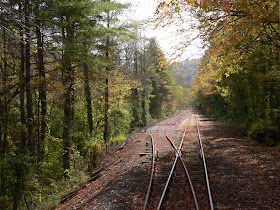We bought tickets to ride the train up the Hiwassee River Gorge to the Bald Mountain loop near Farner, Tennessee, in mid-October, 2012. The trip begins at the restored L&N station in Etowah, Tennessee. A museum, gift shop, ticket office and restrooms are located inside the depot. Additional restrooms are located adjacent to the parking area.
 |
| L & N Depot, Etowah, TN |
Instead of boarding a train at the station, we boarded school buses for the seven mile trip to the Gee Creek Campground area of the Hiwassee Scenic River State Park. Near a railroad crossing in the park, we walked past GMTX 2004, an EMD GP-38 locomotive, and boarded the four-car train. The cars have all been restored and maintained by the Tennessee Valley Railroad Museum. A small concession and gift shop is operated out of a former restroom lounge area in one of the cars. Each car has at least one operable restroom. There are no open cars on this excursion, but the rear vestibule on the last car was open with only a waist-high accordion-style gate across the passageway. In addition, there were a couple of open dutch doors in the vestibules at the middle of the train. These open areas provided an opportunity for photography without reflections from the windows.
 |
| Bottom land along the Hiwassee River |
 |
| Crossing the Hiwassee River |
 |
| Bridge over the Hiwassee River |
 |
| The tracks closely follow the river upstream |
 |
| Apalachia power house and foot bridge |
 |
| Beautiful fall colors across the foot bridge |
 |
| Crossing Tennessee Highway 68 |
 |
| The loop begins as we pass under the trestle |
 |
| Running the locomotive around the train at Farner, TN |
 |
| Crossing the trestle to begin the loop on the return trip |
 |
| Vivid fall colors on both sides of the gorge |
 |
| The second track opens up the forest "tunnel" |
 |
| Fall colors explode along the track |
Our return trip did not stop at Gee Creek, but continued another three miles to another passing siding where the locomotive again uncoupled from the train, switched tracks, ran past the train, switched tracks again, and recoupled to the other end of the train. We then returned to Gee Creek where we boarded buses for the return trip to the depot. The excursion we chose was just under four hours and cost $38 per person plus a $3 service charge per order. The entire bus and train trip is non-smoking.
The excursion website is http://www.tvrail.com/hiwassee/index.php. Several webpages are out of date, but the people answering the telephone are both friendly and knowledgeable.







































